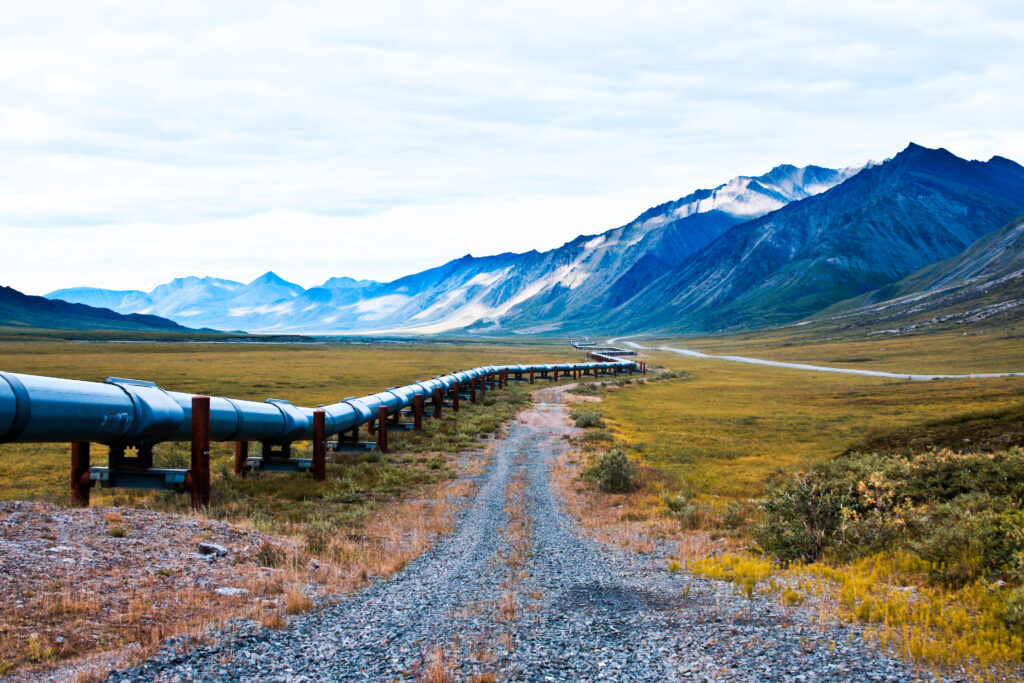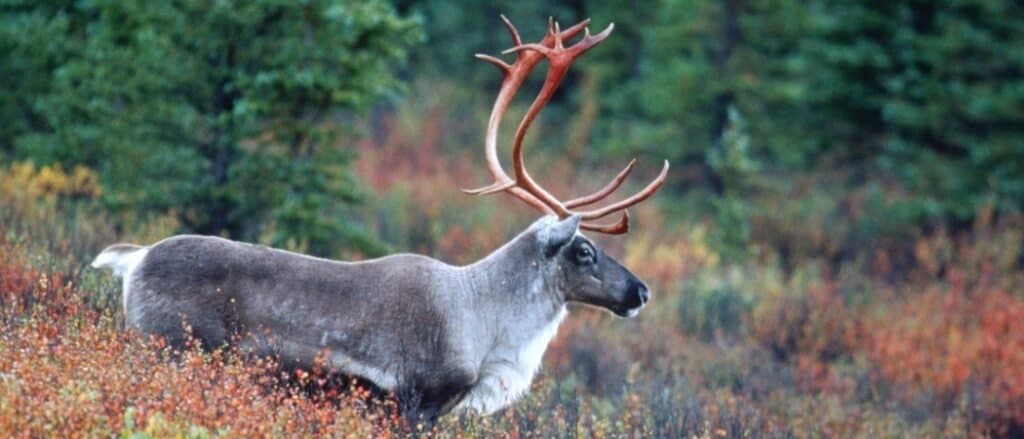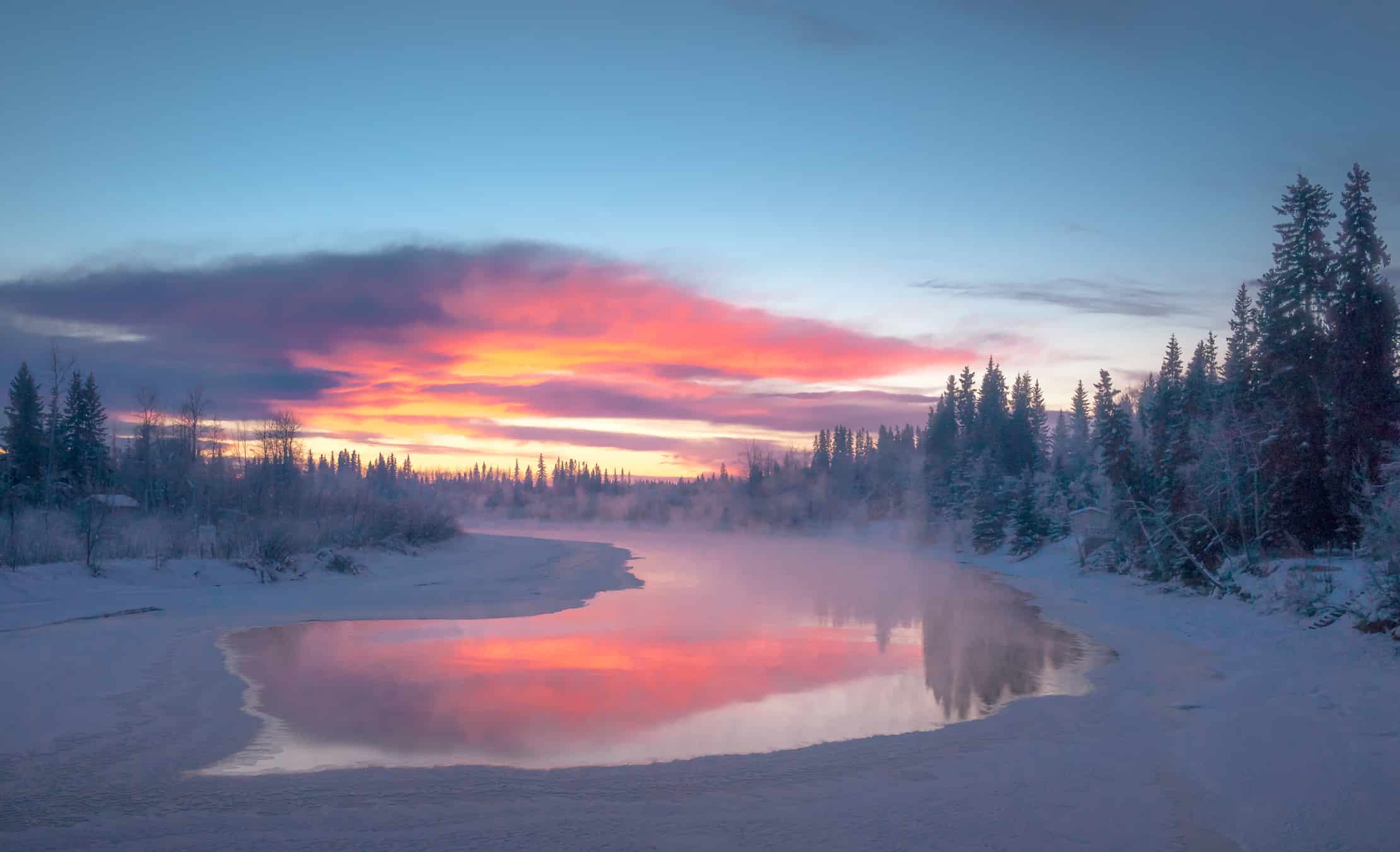Alaska has frigid winters and vast tundra, but did you know that the hottest place in the state gets to 99 degrees Fahrenheit? The state is known for its rugged terrain, stunning wildlife, and record-cold temperatures. However, Alaska has a hidden secret — parts of the state can get extremely hot compared to its contrasting winter wonderland.
Since the state spans over 665,400 square miles, the temperatures vary greatly depending on the region. In the northern part of the state, temperatures reach extreme lows and often don’t get that hot. However, the middle part of the state can see sweltering weather.
Since the state has varying climates, we’ll explore the area that gets the hottest. Ironically, it’s also the coldest region in the state. So, let’s discover the absolute hottest place in Alaska.
Discover the Absolute Hottest Place in Alaska (99 °F)!

Fairbanks is both the hottest and coldest place in Alaska.
©Michael Rosebrock/Shutterstock.com
The hottest place in the state is interior Alaska. The boundary for interior Alaska includes the central region of the state. It spans over 175,000 square miles and can be identified by the area between the Alaska Range to the south and the Brooks Range to the north.
To put this into perspective, interior Alaska is the same size as Indiana, Pennsylvania, Ohio, and New York State combined. As you can see, that isn’t small and takes up to 30% of the state’s land mass.
While most of interior Alaska is wilderness, a few areas have towns and villages. Fairbanks, known as Alaska’s Golden Heart City, the hottest place in Alaska, is the most populated and largest city. While most people know the town as a central transportation hub and a great place to see the northern lights, the summers are known to be dreadfully hot.
The hottest recorded temperature for Fairbanks is 99 degrees Fahrenheit, recorded on July 28, 1919. However, the town has seen plenty of temperatures recorded in the 90s degrees Fahrenheit range.
Where is Fairbanks, Alaska Located on a Map?
Fairbanks, Alaska rests near the center of the state along the Chena River. The city is situated in the Tanana Valley, sandwiched between the White Mountains to the north and the Alaska Range to the south. Anchorage is approximately 360 miles due south, and roughly 400 miles east lies the border between Alaska and the Yukon Territory.
While its summers can reach very high temperatures, the city also experiences frigidly cold winters, making it a hub for dog sledding, ice sculpting, skiing, and snowboarding. Summers are favorable for hiking, fishing, and wildlife viewing.
Fairbanks’s Rich History
Fairbanks has a rich history and is one of the first places to become an established town in Alaska. The area the city was built on was home to the Athabascan Tribe for thousands of years. However, it wasn’t until 1901 that the town officially became known as the Fairbanks we know today.
Fairbank’s Humble Beginnings
The town was established due to the gold rush in the late 1800s and early 1900s. Felix Pedro was an Italian immigrant mining for gold and found some in the area where Fairbanks was soon to be located. Soon after, many other miners flocked to the region, hoping to find more gold. Then, Fairbanks was established as a settlement by E.T. Barnette in 1901.
The town then became a trading settlement due to its location next to the Chena River. After it was established, the town experienced rapid growth as more miners, traders, and prospectors joined the areas in search of opportunities.
Instead of being the hometown of the Athebascan tribes, it was now a commerce hub for anyone. Traders worldwide came to sell goods, while many professions were attracted to new opportunities and lifestyles.
World War II

The railroad system connects Fairbanks to other towns in the state.
©Richard N Horne, CC BY-SA 4.0, via Wikimedia Commons – License
Soon after, the town turned from a commerce point into a military base during World War II. While most of the war occurred at Dutch Harbor in Unalaska, Alaska, an army post was being constructed in Fairbanks. Due to Fairbank’s trading port, the town became an important central point for the troops.
Many people came together to construct what is now known as the Alaskan Highway. It was designed to help bring soldiers to and from the base. After the war, Fairbanks became a trading hub and commerce point for Alaskans, primarily due to the construction of the Alaska Pipeline.
The Trading Hub Era

The TAPS transports oil for over 800 miles.
©iStock.com/kyletperry
The Trans-Alaska Pipeline System (TAPS) was built in the 1970s and was designed to help transport oil throughout the region. Alaska is rich in oil, but transporting it by vehicle would be dangerous and expensive. A solution to this was the TAPS system which allowed oil to be transported through a giant pipeline from one location to another.
The TAPS spans over 800 miles and is owned by the Alyeska Pipeline Service Company. However, the system was created as a shared collective at the time.
This leads the town to shift from a trade port to an economic land of opportunity. Many jobs opened up, and more people moved into Fairbanks, hoping to work on the TAPS system. Fairbanks saw a large influx of people and an increased population during this time.
Modern Day Fairbanks
Now, Fairbanks is known as the center for commerce and transportation and is home to Fairbanks University. Many residents have grown up in the area and continue to live there. On the other hand, many other people come for seasonal or year-round job opportunities. Aside from that, tourists are also attracted to Fairbanks due to its vast wildlife and the town’s beautiful view of The Northern Lights.
Average Temperatures
The town of Fairbanks sees an average of 70 degrees Fahrenheit during the summer months. The peak tends to be from June to mid-August, as it can reach the mid-70s or higher. On rare occasions, the area has been known to reach well above 80 degrees Fahrenheit and, in some extreme cases, above 90 degrees Fahrenheit.
Record High Temperatures

The town of Fairbanks reached a peak of 99 degrees Fahrenheit.
©VladisChern/Shutterstock.com
While the hottest temperature occurred in 1919, there have also been peaks of scorching weather. The hot weather doesn’t occur all at once but happens every so often in 100 years. The hottest summers have been during:
- June 15, 1969 (96 °F)
- June 21, 1991 (94 °F)
- July 11, 1975 (94 °F)
- July 10, 1975 (94 °F)
- August 5, 1994 (94 °F)
These are just a few of the hottest temperatures. Fairbanks has seen consistent spikes into the 80s degrees Fahrenheit.
Fairbanks Population
While Fairbanks might not seem like a large town, it does have a significant population. Since the city has many commercial jobs, many people fly in to work year-round or for a season. As of 2023, Fairbanks has a population of 32,868.
The town has found the most growth during 2011 and 2012, where the population increased by more than 2%. However, the area saw the most considerable increase during the 1940s and 1950s due to World War II. Currently, Fairbanks has an annual increase of 0.25% in population.
The Surrounding Fairbanks Wildlife
Fairbanks has abundant wildlife surrounding the town in all directions. There are many conservation and protected wildlife areas dedicated to not only protecting animals but also viewing them. With a wide wildlife area, here are some animals you can find outside the city.
Interior Alaska’s Mammals

Reindeer can be found just outside of Fairbanks, AK.
©iStock.com/KenRinger
Interior Alaska is home to many stunning types of wildlife. Some of the most common that you’d find outside of Fairbanks are moose, reindeer, and caribou. They can be found roaming Alaska’s tundra and woodland areas.
You might also encounter Dall sheep and wolves, which frequent mountainous regions. Wolves travel in packs and can often be found circling the edges of the town. However, they rarely ever go near humans.
Small critters such as beavers, foxes, and bats can also be found. Some predators you might discover include brown Bears and black bears. Many birds are migratory, but you can see them during the spring and summer. Fairbanks is home to bald eagles, dark-eyed junco, mountain bluebirds, and even boreal chickadees.
While not directly inside Fairbanks, marine animals such as humpback whales, orcas, and gray whales can be found. It’s around a 300-mile journey, but you can find whales to the south of Fairbanks. The Alaskan Gulf is home to plenty of marine mammals you won’t get to see anywhere else.
Interior Alaska’s Aquatic Life

Chena River is home to many types of fish.
©iStock.com/Elizabeth M. Ruggiero
If there is one thing Alaskans love, it’s fishing. Fairbanks is close to the Chena River, home to many aquatic species. Fish you can find include rainbow trout, king salmon, northern pike, and the Fairbanks grayling. Anglers also try to catch halibut, Chinook salmon, and Alaskan pollock.
The photo featured at the top of this post is © iStock.com/5279210107801613
Thank you for reading! Have some feedback for us? Contact the AZ Animals editorial team.







